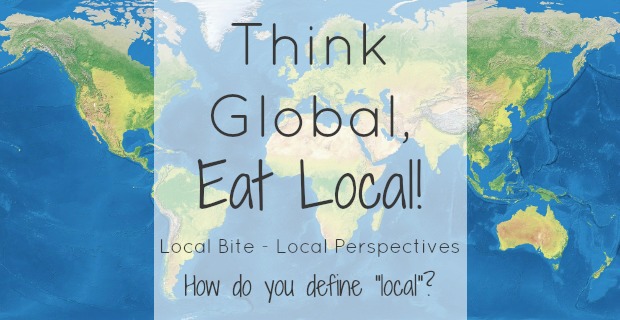Welcome Teri, from Homestead Honey as our next Local Perspective! I have to tell you, the more I get to know Teri, the more I want to be like her when I “grow up”. (No, I’m not joking.) Not only did she pack up and move half way across the country to really fulfill her dream to be a homesteader, this summer she is also co-teaching a 4-week eCourse called, “Empowered Eating” which begins on August 25th. In her course, participants will explore local food issues in a supportive online community, complete a personalized local food challenge, and learn to preserve the plant and animal products available in your region. Sounds right up my alley, right? I hope it’s right up yours, too! You can learn all about the course here, and please hop around her blog a bit…there is so much inspiration in those pages, I promise you won’t be disappointed!
xoxo,
M
*****

Hello! I’m Teri Page, from the blog Homestead Honey. I want to thank to Melissa for inviting me here to write about my experiences eating local. In my ideal world, I would like to source all of my food from farmers with whom I have a relationship. But in reality, I would say that my family is successful in sourcing about 50% of our diet, on average, from within 100 miles. That percentage varies seasonally; in the summer it probably jumps to 75%, and in the winter, I would estimate that it drops to 25%.
Before my family moved to our current homestead in Northeast Missouri, we lived for thirteen years in the Willamette Valley of Oregon. Thanks to a large greenhouse, we were able to grow and eat homegrown produce almost all year round. Tomatoes in the hoop house would ripen slowly until really cold weather hit in late November or December. Kale and other hearty greens would grow almost year round, and come February, I was harvesting carrots and beets. We also raised pigs for meat, goats for dairy, chickens for eggs, and honey for sweetener.
Whatever food we could not produce ourselves was easily sourced locally from one of many organic farms. Eating locally was an endeavor that was well-supported in our community, and we eagerly embraced the movement from a community-building, local economy, and environmental/sustainability aspect.

A year and a half ago, we packed up and moved halfway across the country to Northeast Missouri, where we began to build a homestead from scratch on raw land. The goats, bees, and chickens were left behind in Oregon, and we started anew by building a sheet mulch garden.
In our first year garden we enjoyed fresh vegetables all summer long until a killing frost in October, but the garden did not produce enough to do much preservation. I sought out a local farmer and bought bulk quantities of turnips, sweet potatoes, and winter squash. But despite my efforts to squirrel away storage crops, come winter we were frequenting the supermarket, and broccoli and cauliflower from California became standard fare.
I am grateful that we have access to organic produce at all, but the truth of it is that the quality is poor, both because the demand in our area is not great, so stock does not turn over quickly, and because by the time the vegetables and fruit have reached the shelf, they have already traveled across the country, or across the world!
Moving to a true four season climate, where the growing season is about half of what I was used to has been a bit of an adjustment. Here in Northeast Missouri, I have fantastic access to eggs, raw milk, Amish-made butter and cheese, and pastured beef, chicken and pork. We even just learned of a source for local organic wheat. But fresh produce is much more of a challenge in our zone 5a climate.

When the same local farm from whom I purchased such great storage vegetables announced his 2014 CSA program (or “Veggie Adventure,” as he likes to call it), I decided almost immediately to invest in a share. True, I will still grow a large garden, but the benefits of being a CSA member were too compelling. By joining his Veggie Adventure program, I could:
- Funnel my money into local agriculture, directly supporting a farmer whose background in soil science and passion for organic growing methods produce beautiful nutrient-dense food.
- Think beyond the grocery store. In early April, when I begin getting a share, I will need to be infinitely creative in my use of spring offerings. What exactly will I do with bundles of radish, spring onions, chickweed, mustard greens, lettuce, and mache?
- And most importantly, joining a CSA will commit our family to a seasonal diet. Our food budget is already spent on local foods, and now we will enjoy eating what our Northeast Missouri bioregion can provide.
The ease with which I can provide my family with a local diet has shifted significantly in the past year, but I’m excited to find new creative ways to support local agriculture. Sure, I will still buy chocolate and black tea and spices, but it feels really good to base our meal plan on food that is grown by people in our community.
 Teri Page lives in Northeast Missouri with her husband and two young children. Together they are creating an off-grid homestead on 10 acres, complete with tiny house building, organic gardening, Waldorf-inspired homeschooling, and much more! Join her on her blog, Homestead Honey, and on Facebook, Pinterest, Twitter, and Google +.
Teri Page lives in Northeast Missouri with her husband and two young children. Together they are creating an off-grid homestead on 10 acres, complete with tiny house building, organic gardening, Waldorf-inspired homeschooling, and much more! Join her on her blog, Homestead Honey, and on Facebook, Pinterest, Twitter, and Google +.

